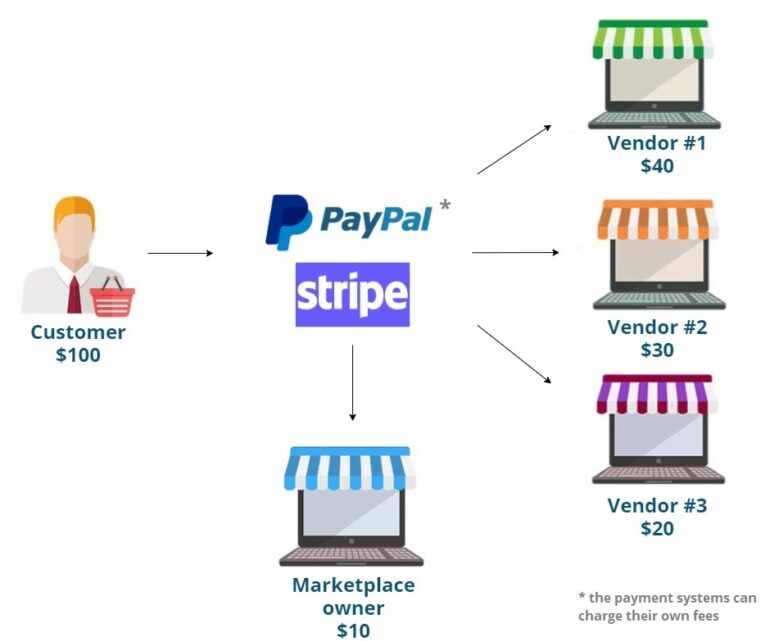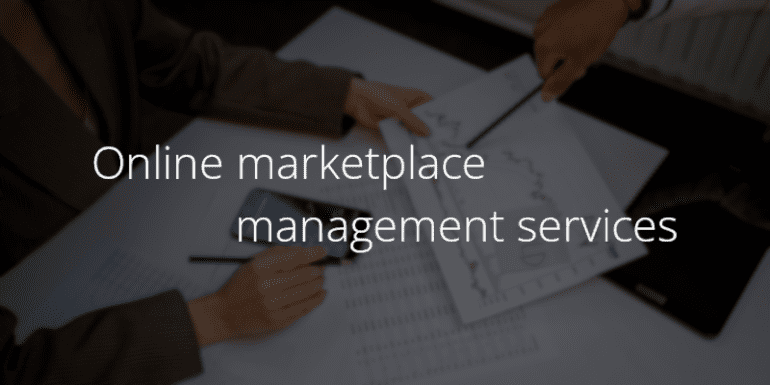How to automate marketplace routine with online marketplace management services
If you are reading this article, you might already be familiar with eCommerce and marketplaces technology. Not yet? Are you planning to open a marketplace or become a vendor and looking for possibilities for expansion in advance? This article is for all types of researchers.
We will take a look at the inner structure of marketplaces and find which online marketplace management services can improve your business processes.
Brief explanation of marketplace technology
eCommerce is an online representation of your business. In simple words, it is a website where you can display your products. Potential clients can find you on the Internet and make a purchase from home. It does not exclude the possibility to have a brick-and-mortar store in parallel.
The idea of online bargains has been developed and erupted into a powerful business model named Marketplace. Marketplaces is a branch of eCommerce. It is a website but in contrast with previous eCommerce websites, there are a lot of product contributors called vendors. You are not the only seller anymore. There are many of them on the marketplace website. Marketplaces serve to connect a lot of sellers and buyers.
The more complex a business, the more difficult it is to run it. You hire more managers, there are more mistakes and lacks, so it is high time we introduced advanced technologies for automation. Management of products on a marketplace may appear to be a time consuming matter for vendors. But before we jump to the topic on how to manage marketplace stores effectively, let’s see what we are dealing with.
How flow goods, money, and documents in multi channel marketplaces
Each marketplace has its own established features of how it is operated. It is important to know what branches each sphere has.
Goods
The logistics is very simple there two basic types of organization goods flow:
- Fulfillment by seller (FBS). Products are stored by vendors, they process orders, pack and send the ordered products themselves. They are also responsible for processing the returned products. This scheme might be a bit challenging for vendors since all steps depend on a vendor. It is very important to keep the speed of services otherwise you will lose your rate and image.
- Fulfillment by operator (FBO). A vendor is shipping a batch of its goods to the certain marketplace warehouse and a marketplace is responsible for further transportation and return of goods. This scheme is preferable for both sides: a marketplace can be sure that a customer gets their product in time and a vendor can leave the logistics routine and turn to improving other parts of their businesses.
Money
There are three main types of how profits are distributed between a marketplace and vendors:
1. From a Marketplace to Vendor. After a purchase money is deposited into a marketplace bank account and at the end of a certain period the sum is redeployed among vendors according to their sales. A marketplace sends money without a service fee.
2. From a Vendor to Marketplace. A vendor gets a whole sum for a purchase on it’s bank account. After a certain period of time they should pay the service fee for all the purchases that have been made for this period.
3. To a Marketplace and Vendor at once. After a purchase the sum of money is automatically divided into two parts for a vendor and the marketplace and sent to them. There are two major payment systems: Stripe Connect and PayPal Commerce Platform. Both are available on CS-Cart Multivendor.

Note: The service fee varies from 5 to 25% for each product.
Documents
Notifications can be sent on a marketplace platform or by email either. They can be useful in different spheres. Notifications serve for marketing and informative purposes. Shipping and ordering processes, any other changes in goods exchange, updates can be tracked like this.
Sometimes a basic accounting system is build-in and a marketplace can generate basic invoices. They are ready-made patterns of documents that should be signed or read by clients or vendors. However, for big businesses more complex ecommerce marketplace management services are advisable.
Marketplaces usually provide vendors with a monthly report. It helps to monitor and control business efficiency. It might include total profit for the month, a list of product, service fee sum, and some other stats. Vendors can find them in their account or email. It is a double check. You can compare the marketplace’s reports with your paper documentation to find mistakes or growth points.
The common process of managing multiple marketplaces
Automation systems are not a necessity for all vendors. Progressive eCommerce marketplace management is recommended to those who have a big flow of orders. If you have less than 30 orders per day, you can cope with it yourself. So, let’s see how it works in this case:
- A vendor unloads their range of products in the .xls format right on the marketplace or via marketplace’s API from the supplier.
- Create product listings. They include several photos of a product, description, and prices
- Optimization of marketing strategy for products
- Processing orders
- Monitor statistics and regulate the flow of new products and remainings
- Provide customer service such as answering comments, monitoring status updates
- Control money flow
- If a vendor follows the fulfilment by seller scheme, they also ship their products
All this is made manually and requires a lot of time. As time passes, the number of orders can increase and you can be stuck in the hustle and bustle of the uploading-processing-shipping routine.
This inevitably leads to:
- More mistakes
- Slower order processing
- Delays in shipping
- Worsening of rates
- Lost customers’ trust
To sell on multiple marketplaces successfully, you should turn to automation marketplace management platforms.
Automation systems in eCommerce marketplace management softwares
These systems are an indispensable tool for vendors and business in general. We are going to figure out how marketplace integration software works and what are the advantages.
CRM in online marketplace management
You definitely have heard a word about CRM. This technology terrifies young business owners but it is not a difficult or abstract concept. It is not a measure to make your business even more complex. In simple terms, the prototype of a CRM may be any table, for example, an Excel table, where you store the information about customers and products. However, CRM have some more handy features if their configurations are not basic:
- Form a unified database
- Register information about deals, telephone calls, and transactions
- Filtering features are available. You can filter clients according to a specific feature
- Automates document flow
- Classifies and sends requests by its purpose
- Control deadlines
- Provide analysis of products, marketing employees
- Provide mailing services by email or SMS
The main purpose of a CRM is to collect all the information about products and client services in one place and allow people to manage business via it in a convenient way. CRM is mostly about the optimization of connection between a seller and customer.
Note: you can reduce up to 95% of manual work by introducing a CRM system.
Automated accounting system
Apart from client services which for sure plays an important role in the multichannel marketplace platforms, there is another side of a business—financial. There are also special systems for optimization in this sphere.
The benefits of automated accounting systems:
- Modern automated systems are very secure and you can be sure that there will be no leaks, accidents, and losses.
- Time-saving. You do not have to do a double-check of manual work to exclude mistakes.To find certain information becomes even faster than ever. You have a number of standardized documents which you can send in a moment and your client can sign in one klick.
- Digital accounting can store much more data than paper one.
- Sustainable. It is an eco-friendly way to keep documents.
- It is cheaper. You can save money on stationery, document storage and a number of accountants.
- Business can be scaled easier. One of the major advantages is that digital accounting does not depend on human resources, a certain place and requires a minimum place for storage and therefore it can grow as fast as your business does. You do not have to make special preparations or hire more people before expansion.
To conclude, with documents in one place it will be easier to produce financials and make online marketplace management more efficient.
Automated storage and retrieval system
The last but not the least important sphere for vendors when running a store on the multichannel marketplace platform is products. Automated storage and retrieval systems are a combination of equipment and method that refers to the issue of how to record products correctly and how to avoid mistakes.
The benefits of these systems:
- Increase storage capacity. Technologies help to use maximum of the space given
- Increase accuracy and help to monitor remains
- Reduce labour force. Technologies help to figure out the minimum number of workers
- Organize work in an ergonomic way. This method decreases the number of injuries when gathering a package.
These systems are indispensable for massive amounts of products.
Payment integrated systems
The important part of the business is how payments are organized on a marketplace.
There are top 3 payment platforms for marketplaces available worldwide:
- PayPal. It is globally famous and has won people’s trust. Advantages:
- Available globally except for a list of countries* and accept more than 100 currencies
- Strong protection measures. The security tools are based on artificial intelligence and machine learning. Corresponds to PCI DSS.
- It has a special service called PalPay Commerce Platform to divide money between a marketplace and a vendor immediately.
- End-to-end payment. Have a vast range of possible payment services. Multiple payments are available.
*Belarus, Burma, Iran, Iraq, Liberia, Nigeria, North Korea, Sudan, Syria, Western Balkans, Zimbabwe.
- Stripe Connect is “the fastest and easiest way to integrate payments into your software platform or marketplace” as they write about themselves on their website. Advantages:
- Globally available except for the United Arab Emirates and accept more than 135 currencies
- Easy in usage for developers and clean API’s
- As well as PayPal it has a service to divide money between a marketplace and a vendor at once.
- Multiple payments are available
- High-level security that includes Stripe’s original tool; Corresponds to PCI DSS.
- Braintree belongs to PayPal but it is a separate project. The whole name is Braintree Marketplaces. Advantages:
- Available only in US and accept more than 130 currencies
- High-level security corresponds to PCI DSS
- Multiple payment acceptance and a lot of payment methods are available.
Summary
In conclusion, there are a lot of sides and all of them require decent attention. Marketplace integration softwares is the key to success. Technology allows us to leave the routine tasks in favor of more important questions. The main purpose of all the systems is to make as many processes as possible automatic. It makes work clear, accurate, and understandable. Transparent environment makes your business more appealing to people. With these measures you definitely could sell on multiple marketplaces effectively.
Yan Anderson is the Head of Content Marketing at CS-Cart with over 10 years of experience in the eCommerce industry. He's passionate about explaining complicated things in simple terms. Yan has expertise in building, running and growing eCommerce marketplaces. He loves to educate people about best practices, new technologies, and trends in the global eCommerce industry.

